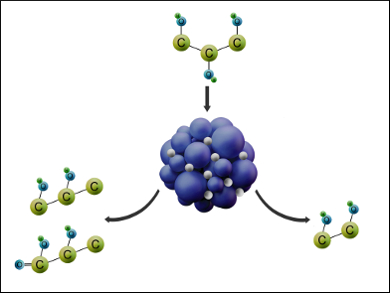Nickel is a promising catalyst for hydrogenolysis because of its low cost, high activity, and resistance to poisoning. However, there are significant challenges to its industrial use, for example, the poor hydrothermal stability of nickel compared to noble-metal catalysts and the difficulty in using nickel catalysts for the production of desirable C3 chemicals (e.g., 1,2-propanediol) by C–O bond cleavage.
One strategy to enhance the efficiency of nickel-based catalysts for the production of C3 products is to alloy the metallic nickel with other transition metals. This results in the promotion of C–O bond cleavage or the inhibition of C–C bond cleavage.
Bin Chen, Xiangguang Yang, and colleagues, Changchun Institute of Applied Chemistry, Chinese Academy of Sciences, have prepared a series of modified nickel catalysts. The team investigated the role of bimetallic effects on the selective cleavage of C–O and C–C bonds in glycerol hydrogenolysis under alkaline conditions, a model reaction for the utilization of biomass-derived polyols.
Compared to Raney-Ni, their Raney-Ni6Ag was found to be more active for glycerol conversion and more efficient for C–O bond cleavage, affording higher selectivity (88 %) toward C3 products at the same level of conversion of glycerol (approximately 70 %). The researchers suggest that a better understanding of the catalytic characteristics of nickel catalysts for the hydrogenolysis of glycerol could contribute to a new generation of nickel-based catalysts for biorefineries.
- Bimetallic effects of Ag-modified Ni catalysts and their synergy in glycerol hydrogenolysis,
Bin Chen, Bin Zhang, Yibo Zhang, Xiangguang Yang,
ChemCatChem 2016.
DOI: 10.1002/cctc.201600239




